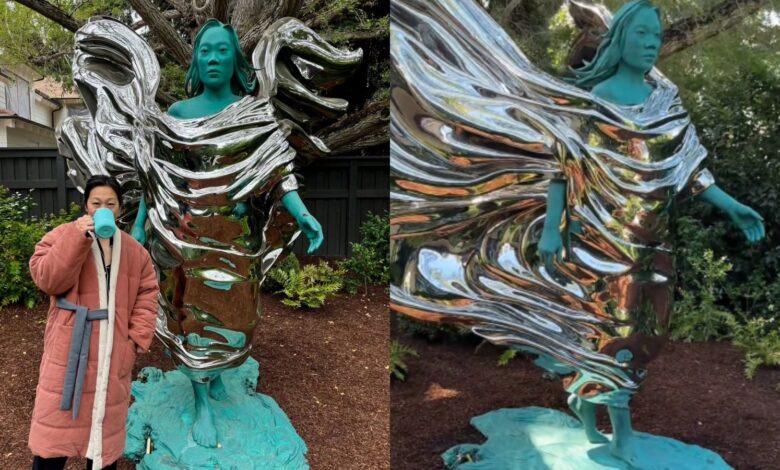Mark Zuckerberg’s 7-foot backyard statue of wife Priscilla Chan is actually rooted in ancient Roman tradition

“Husbands everywhere are shaking”. Priscilla Chan poses alongside her 7-foot statue(Photo: Instagram/zuck) The internet in a clean swoop, has dubbed Mark Zuckerberg husband of the year and rightfully so. On Wednesday, August 14, Mark took to his Instagram handle to share a picture of his latest art investment — his wife! In Mark’s eyes, wife of over 12 years Priscilla Chan IS art and he has no qualms in having an unmissable reminder of it planted in his backyard to cherish everyday. The photo and video shared Mark featured a mammoth, 7-foot tall statue, symmetrically placed under a tree in their backyard. Resembling Priscilla every inch, the teal installation appeared to be mid-stride, enveloped in a silver-esque-holographic robe of sorts. Standing right under it, cool as a cucumber, was the real Priscilla, in a puffy pink robe sipping on her cuppa joe. Mark’s 2-line caption partly read, “Bringing back the Roman tradition of making sculptures of your wife”, a true mic drop moment if there ever was one. While the statue of course puts Mark and Priscilla’s love story in the spotlight, the question of the hour right now is, how much did the Romans love their wives? And also, what tradition of theirs is Mark referring to? It’s all about loving your familyThe Romans were true and ‘blue’ family men — pun intended. The reference about Romans erecting statues in honour of their wives actually falls under the larger ambit of something called ‘pietas’. With loyalty and devotion being the core values of pietas, Britannica explains it as a sense of religiosity carrying the “personification of a respectful and faithful attachment to gods, country, and relatives, especially parents”. While there isn’t a specific tradition per se which immortalises wives through statues, it is all part and parcel of the sentiment of family (and state) first. The whole ‘personification’ aspect of pietas, as per Danyang Zheng’s study, The Memetic Connotations and Evolution of “Pietas” in Roman Ideology, Ethics and Politics, essentially began during the reigns of Augustus and Emperor Constantine, in the form of coins which later also went on to include busts and sculptures. Pietas here, referred to a Roman Goddess of the same name, whose virtues embodied the aforementioned sentiments, and whose hooded-likeness was carved onto coins. Often these coins would also carry the likeness of women from imperial families, as a sign of devotion to them. Circling back to the Priscilla statue, this is probably the sentiment Mark was referring to in his caption. The Priscilla statue is the work of Daniel ArshamIn the art and sculpting sector, Daniel Arsham’s hands and aesthetic are globally renowned. Daniel, who is based in New York, has an affinity for the Statue of Liberty shade of teal which the Priscilla statue carries. That in congruence with the holography is actually a template the art and sculptor has committed to before. Case in point, his currently ongoing exhibition in the Venetian church of Chiesa di Santa Caterina. The key note attraction there is the ‘Bronze Eroded Split Head’, an installation sculpture towering at a height of a little over 8-feet, also carrying the teal-holography union. Taking this as precedent, the Priscilla statue then too, appears to be made out of crystal and volcanic ash as the base materials. Most of Daniel’s work is deemed to be referencing the in-betweens of the past, present and future. What then, could possibly be a better allegory for love. Coming back to the couple, “The more of me the better?”, signed off Priscilla in the comments section on Mark’s post, giving her stamp of approval to the truly ‘big’ gesture.







